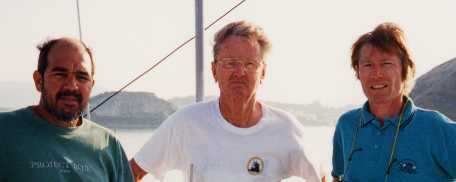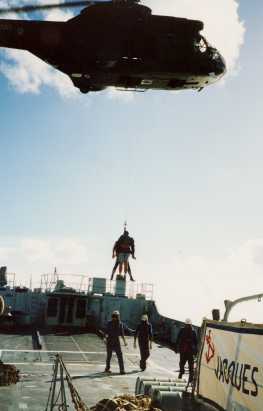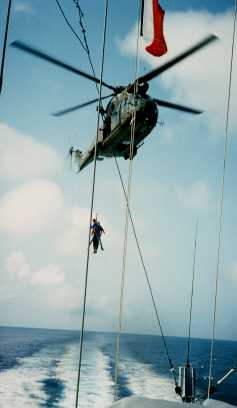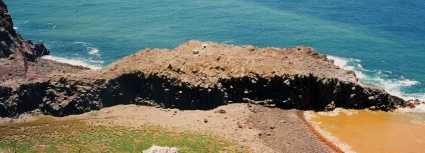


|
FK8GM |
FK8CR |
FK1RF |
We were allocated the special call sign FK5M by the administration of Telecom in Nouméa. We boarded the French Navy patrol boat " La Moqueuse " on december 2d.
The French Navy regularly calls in those remote islands to show the flag and they sometimes offer their help to other services and departements. This time, the three military corps (Army, Air Force and Navy) were present. The Bureau of Meteorology also had a man on board to check the automatic weather reporting station on the island.
 Matthew Island is of volcanic origin and is very
dry. Its highest point at the western end is a peak of 177 metres. There,
craters are spewing sulfurous smoke. At the eastern end, there is another peak
of 142 metres. Between the two peaks there is a 200 metres wide isthmus where
helicopters can land. Sea landings are perilous and can only take place in good
weather.
Matthew Island is of volcanic origin and is very
dry. Its highest point at the western end is a peak of 177 metres. There,
craters are spewing sulfurous smoke. At the eastern end, there is another peak
of 142 metres. Between the two peaks there is a 200 metres wide isthmus where
helicopters can land. Sea landings are perilous and can only take place in good
weather.
 After some military exercises south of the
main land and a stop abeam Walpole Island, " La Moqueuse "
arrived at Matthew island in the wee hours of the morning on Wednesday,
December 4th. One by one , the services personnel, the weatherman and
the three radio amateurs were winched up into a Puma helicopter and then winched
down to the island. The equipment followed and we started to unpack our radio
gear, knowing that we could only stay on the island for 24 hours, including
unpacking, rigging our station and repacking.
After some military exercises south of the
main land and a stop abeam Walpole Island, " La Moqueuse "
arrived at Matthew island in the wee hours of the morning on Wednesday,
December 4th. One by one , the services personnel, the weatherman and
the three radio amateurs were winched up into a Puma helicopter and then winched
down to the island. The equipment followed and we started to unpack our radio
gear, knowing that we could only stay on the island for 24 hours, including
unpacking, rigging our station and repacking.

We had two complete radio stations, each with an ICOM transceiver 751 and an ICOM 730 plus a third just in case. For antennas, we had a R7 vertical and a home brewed vertical half wave for 20 metres. Power was supplied by a 3 KW plant.
The fisrt call went out at 21 :27 and the last contact was made at 11 :32. We made 497 QSO (413 in SSB to 48 countries and 84 in CW to 15 countries). Some may say, those results were not fantastic but we had no propagation toward Asia, Japan and the States, our operating conditions were very basic and the proximity of the weather station produced a strong QRM on all bands.
On Thursdayn, December 5th, 24 hours after our landing on the island it was time to dismantle our station and pack it back. We had to get up early for the task.We had perfect weather and a calm sea for the return trip to Nouméa. " La Moqueuse " was at her moorings in the Naval base of Chaleix at 7 :30 on the Friday.

We would like to thank the French Navy and the French Army who made the expedition possible. We also would like to thank the OPT for allocating us a temporary call sign. We are grateful to the LNDX for the handling of the QSL Cards and to the QSL manager F6AJA, and of course to all the amateurs who spread the news.